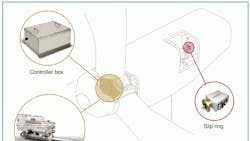Electrohydrostatic actuation modernizes fluid power
In May 2010, the National Fluid Power Association (NFPA) asked its members to develop a 10-year technology roadmap for the hydraulics industry. One motivation is that electromechanical solutions are increasingly being specified in applications traditionally moved with fluid power — power generation, for example. The NFPA identified six main challenges facing the industry as well as strategies to confront these issues:
-
Increase energy efficiency
-
Improve reliability
-
Build smart components and systems
-
Reduce size and weight
-
Reduce environmental impact
-
Improve and apply energy storage and redeployment capabilities
Addressing many of these challenges is one newer technology called electrohydrostatic actuation — or EHA — sometimes known as power by wire. A self-contained unit combines both electric servomotors and hydraulic pumps and valves with a common controller and software. This hybrid technology requires no hydraulic piping, which boosts reliability. EHA can be further optimized for specific applications, thereby reducing size and weight. In this case, motors rotate only when movement is required.
Electrohydrostatic actuators receive power from an electric source and transform an input command signal — usually electric — into motion. These systems often include a servomotor, hydraulic pump, accumulator, and servoactuator. EHA uses fluidic gearing between the electric motor and actuator. Further, while EHA includes hydraulic components and fluid, these are self-contained within the actuator assembly.
Although EHA is not typically used for industrial applications, a few manufacturers have started working with OEMs that leverage hydraulics for applications requiring high force and energy savings. EHA is also a suitable option for electric applications that require redundant or advanced failsafe systems, such as pitch control for wind turbine blades.
Actuation technology differences
To compare actuation technologies, let's examine wind turbine blade pitch control. Adjusting the wind turbine's blade increases turbine power-generation efficiency by maintaining a constant generator speed. Electromechanical actuation (EMA) and electrohydraulic actuation (EH) each comprise about 50% of today's pitch control market. OEMs often specify EH actuators because the accumulator handles the failsafe mode. However, one disadvantage of EH actuation is a big, leak-prone rotary union between the wind turbine's nacelle and hub.
Regarding electromechanical actuation, its chief technology advantage is very high efficiency. EMA is also easy to commission because a manufacturer doesn't need to install many components, as everything is already installed in the hub. In contrast, EH requires a wind turbine maker to install the power unit and hardware in the nacelle. One downside to EMA is the need for batteries in failsafe mode: When batteries spin at extreme speeds, they wear out in roughly six months and require replacement. Another disadvantage of EMA is the gearing itself, which encounters both gear wear and backlash.
One reason EHA is so interesting, and an advantage over EMA, is the lack of mechanical screws, or gearing. EHA uses an accumulator similar to EH to put a wind turbine's blades into failsafe mode. The accumulator is in the wind turbine's hub with the actuator, so there's no need for a battery to run the servomotor into failsafe. Unlike EH, EHA technology makes use of a servomotor pump package that is linked to the actuator and self-contained, so there's no rotary coupling. A disadvantage to EHA is installation because the assembly is a little larger than EMA.
Switching to EHA: Wind turbine application
Let's assume a wind-turbine manufacturer wants to employ a system that controls blade pitch angle to optimize power generation. Switching from classic hydraulics to EHA increases energy efficiency because the pitch control system's motor turns only when the inclination, or pitch, of the wind turbine blade needs to change its angle. Reliability is also improved, as EHA enables a wind-turbine maker to replace a rotary fluid slip ring and accompanying hoses with an electro-optical slip-ring assembly, thereby ensuring the transfer of electrical power and signals across a rotary interface.
Another benefit of EHA technology is that the self-contained actuator acts as a smart system by adjusting the angle of the wind turbine's blades with internally integrated motion controls and diagnostics. Size and weight are also minimized, because electrohydrostatic actuation allows a wind-turbine manufacturer to remove the large hydraulic power unit (HPU) typically located high off the ground in the turbine's nacelle, reducing weight by up to 40%. Environmental impact is reduced as well, as the removal of the rotary fluid slip ring located in the wind turbine's nacelle eliminates leak points found in the slip ring, hoses, and fittings. A final benefit involves energy storage and reuse: Emergency pitch brake accumulators, located in the wind turbine's hub with blade pitch control actuators, provide emergency fail-safe pitch adjustment in case of power failure.
For more information, contact Moog Industrial Group at (800) 272-6664 or Dave Geiger at [email protected]. To read the NFPA roadmap, visit nfpa.com/ourindustry/technology_roadmap.asp.
